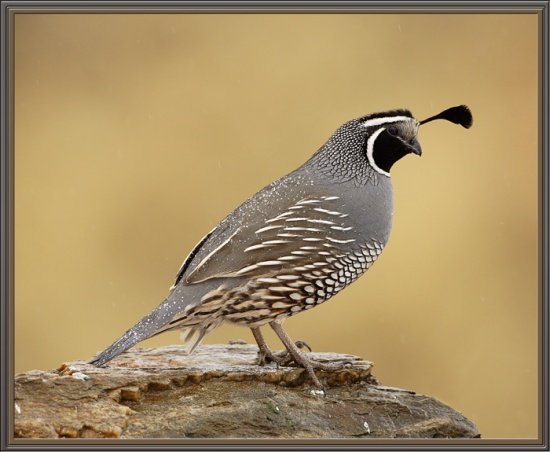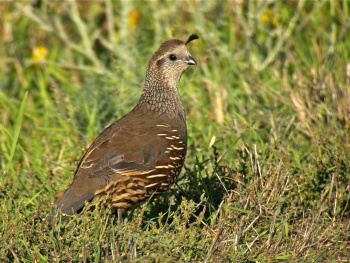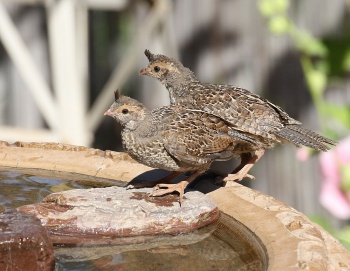
Photo © by digishooter
Wofford Hts., Kern Co., California, USA, December 2006
- Callipepla californica
Identification

Photo © by blubird
Las Gallinas ponds, San Rafael, California, 18 October 2011
150.6 g to 189.5 g (5 - 7 oz.) 25 cm (9.8 in) Males slightly heavier
- Mainly blue-grey and brown plumage
- Distinctive black and white face pattern
- Black and brown feather tips on belly giving a scaly appearance
- Chestnut crown
- Streaked flanks
- Black bill
- Grey legs
Sexes are dimorphic
Males have a black throat; females a greyish throat with black streaks
- Prominent teardrop-shaped plume or a double plume coming off its forehead
Immature: mostly greys and browns which gives it a cryptic look
Distribution
Western North America from extreme southwest British Columbia south through Washington, Oregon, Nevada, and California to Baja California, Mexico. Introduced populations are found in Hawaii and New Zealand.
Taxonomy
Sometimes placed in genus Lophortyx.
Subspecies
Eight subspecies are recognized[1]:
- C. c. californica: Northern Oregon and western Nevada to southern California and Coronados Islands, Mexico
- C. c. orecta: Southeastern Oregon (Warner Valley) and extreme northern California
- C. c. brunnescens: Extreme north coastal California to southern Santa Cruz County
- C. c. catalinensis: Santa Catalina Island (off southern California)
- C. c. canfieldae: Owens Valley of east-central California
- C. c. plumbea: San Diego County south through northwestern Baja California
- C. c. achrustera: Southern Baja California
- C. c. decolorata: Baja California between latitude 25°N and 30°N
Habitat
Dense vegetation near water at low altitudes.
Replaced in montane forest by the Mountain Quail and in desert by the Gambel's Quail.
Behaviour
Diet
The diet includes seeds, leaves, berries and insects.
Breeding
The nest is a shallow scrape lined with vegetation. The clutch consists of up to 12 eggs.
Vocalisation
Common crowing call is a loud "Chi-CA-go." Also sharp, clucking, clicking and spluttering notes.
Movements
Sedentary; maximum movements under 27 km. Dispersal rates increase in response to habitat destruction.
References
- Clements, J. F., T. S. Schulenberg, M. J. Iliff, S. M. Billerman, T. A. Fredericks, B. L. Sullivan, and C. L. Wood. 2019. The eBird/Clements Checklist of Birds of the World: v2019. Downloaded from http://www.birds.cornell.edu/clementschecklist/download/
- Quaglia della California Callipepla californica
- Wikipedia contributors. (2020, April 6). California quail. In Wikipedia, The Free Encyclopedia. Retrieved 08:18, April 29, 2020 from https://en.wikipedia.org/w/index.php?title=California_quail&oldid=949376865
- Calkins, J. D., J. M. Gee, J. C. Hagelin, and D. F. Lott (2020). California Quail (Callipepla californica), version 1.0. In Birds of the World (A. F. Poole, Editor). Cornell Lab of Ornithology, Ithaca, NY, USA. https://doi.org/10.2173/bow.calqua.01
- Carroll, J.P. & Kirwan, G.M. (2020). California Quail (Callipepla californica). In: del Hoyo, J., Elliott, A., Sargatal, J., Christie, D.A. & de Juana, E. (eds.). Handbook of the Birds of the World Alive. Lynx Edicions, Barcelona. (retrieved from https://www.hbw.com/node/53343 on 29 April 2020).
Recommended Citation
- BirdForum Opus contributors. (2025) California Quail. In: BirdForum, the forum for wild birds and birding. Retrieved 11 May 2025 from https://www.birdforum.net/opus/California_Quail
External Links
GSearch checked for 2020 platform.1




